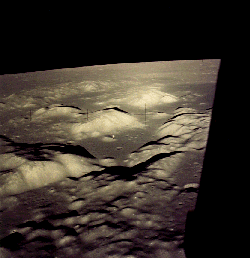The fourth and fifth images in the last row (The first moments of the launch – immediately above) are included here by permission of Lofty Ambitions Blog: loftyambitions.wordpress.com I'm sure you'll enjoy many of the recent behind-the-scenes stories, interviews and images.
After the first launch attempt was scrubbed (On Sept 8th) I spent most of the day at the Kennedy Space Center, and was thrilled to hold an actual piece moon rock in my hand – Black volcanic stone collected during Apollo 17's mission to Mare Serenitatis. Fittingly, there was an intriguing 3D Imax film showing that same day, which covered a lot of this last Apollo mission. Magnificent Desolation will, I'm sure, see wider distribution in the near future – and I do recommend you see it. The incredible images from inside the LM, as Lunar Module Pilot Harrison Schmitt and Commander Eugene Cernan approach the moon's surface and touch down, are as gripping as when Apollo 11 made its first landing. The most compelling scene in the film however, is a wide-angle view of the LM as it descends into the Taurus-Littrow valley. Like a tiny, sparkling jewel, the spacecraft is seen in true scale, dwarfed against the sloping face of the North Massif. This one scene, more than any other in the film, captures the feeling Edwin (Buzz) Aldrin described during Apollo 11's approach: "Magnificent desolation."
The mythic quality of these missions touches people in many ways. Aspirations and technical triumphs aside, the incomparable perspective the moon gives us, I would suggest, is the most important reason for continued lunar exploration. William Anders' iconic photo "Earth Rise over the Moon," taken as the crew of Apollo 8 watched our small blue planet rise over the moon's cold, colourless horizon, reminds us that our home too is a precious gem. This view of earth, as an island of life in the depths of space, has been called the most important picture ever taken, and, as the world seems caught up in petty squabbles and trivial distractions much of the time, a regular reminder of our place in the universe could be helpful. Our existance here on earth, if we do not keep the "Big Picture" in mind, may be as precarious as those little space craft that once sailed above the moon.

Apollo 17 approaches the Taurus-Littrow valley.
NASA photograph AS17-147-22464
To view more photographs taken by the Apollo 17 crew, see:
http://next.nasa.gov/alsj/a17/images17.html